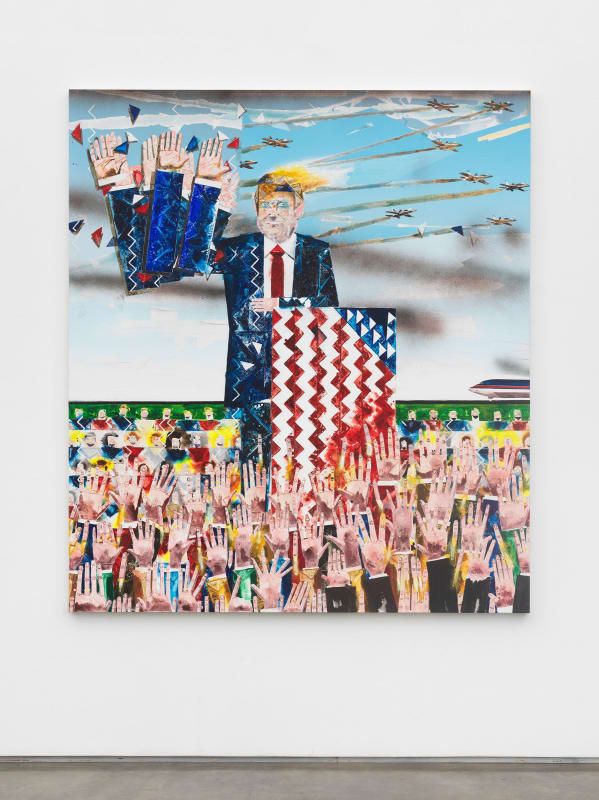BY ALEX GARNER
Barnaby Furnas’s recent exhibition “Frontier Ballads” explored stereotypes of American national identity, from the deceptively romantic ideals of the Wild West to the terrifying reality of Trump rallies. All but one of the twelve paintings portrayed white figures, and subjects were repeated throughout. The show included two works depicting Mount Rushmore, two of women singing and holding farming tools (echoing the composition of Grant Wood’s American Gothic, 1930), and two of men with lassos riding large steeds. The viewer first encountered The Gunslinger, 2018, in which the image of a cowboy’s silhouette and firearm are duplicated and layered to suggest the rapid movement of a motion-picture projection. As the artist recalled our country’s glorified history of violence, the show’s narrative, which took on the presidency of Donald Trump, became increasingly forceful.
Furnas created these paintings in collaboration with the art and engineering company Artmatr and with the support of the MIT Media Lab, using digital and robotic devices, in a process that seems counter to the artist’s nostalgic subject matter. Although still decipherable, most of the figures were rendered in geometric forms, with dispersed pigments conveying smoke or blood splatter. Triangles repeated throughout; The Adventurer, 2018, depicted an explorer on a camel, face reduced to light-pink triangles, the pyramids reflected in his portable-telescope lens.
In Mt. Rushmore No. 2, 2018, the mountain was similarly rendered, taking up most of the canvas, but in the center foreground a flying eagle clutched a snake in its talons, revealing the predatory nature of the American freedom symbol. Completed in 1941, the Mount Rushmore monument is a powerful example of how white European colonizers took land and carved their likenesses into it. American colonization continues: Only a little more than a year ago the United States government refused the pleas of American Indian protesters from South Dakota’s Standing Rock Reservation to halt the construction of a pipeline that would threaten their land.
Adjacent to the two paintings of Mount Rushmore were full-body, standing portraits of Trump. In The Rally, 2017–18, black exhaust from a plane streaks the blue sky, the president’s hair appears to be on fire, and a misshapen American flag—its red and white stripes zigzagged—is draped over his arm. This frightening image shocked upon first encounter, as a sea of outreaching palms beneath him seems to offer him unconditional support. In Rally No. 2 (The Octopus), 2018, Trump is rendered in red, white, and blue triangles, again presiding over upraised arms, presumably all belonging to men: White cuffs peek out from suit jackets of different colors, and many of the hands have gold wedding bands. The composition evokes Russian propaganda posters from the mid-twentieth century that depict Stalin and Lenin amid fawning crowds; sixteen disjointed hands circle the president (all of which look tiny in comparison to his body), although the shapes within the painting resemble something closer to a patchwork quilt.
The exhibition closed with scenes of the death of America, played out in Untitled Remains, 2018: A figure in a blue colonial jacket—likely George Washington—lies supine on a bed of grass, a mirror image of his wounded body reflected in a nearby pool. Eagles, holding red snakes in their mouths and claws, soar around him. Blood shoots geyser-like from his many wounds. A crow perches on the man’s belly, his eyeball in its beak. Furnas may knock you over the head with his politics, but “Frontier Ballads” posed several important questions, fundamental not only to art history but also to grander narratives of origin and identity: Where do we come from, and where are we going?


